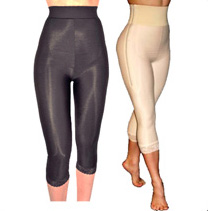
Liposuction or lipoplasty is a cosmetic procedure that uses gentle suction to remove fat deposits from different areas on the body. Some of the most common areas treated include the thighs, hips, buttocks, or abdomen.
What to expect after surgery
On average, liposuction surgery takes between one and five hours. It is typically done with general or local anesthesia depending on the extent of the procedure. You will be able to leave the treatment center after your surgery, although you will need someone to drive you home. For your recovery, expect to spend several days resting before you are able to gradually return to your normal activity level.
Following surgery, you can expect the treated area to feel sore and tender. Many patients describe it as being similar to a large bruise. In some cases, a visible bruise may also develop. Typically, the skin is red for a few days. If large areas of the body have been treated, pain medication may be prescribed to reduce your discomfort. For patients who undergo tumescent liposuction, which requires the injection of large volumes of saline solution, this liquid may drain from the incision sites for a few days. The area will also be swollen; depending on the amount of swelling and the volume of fat removed, you may not be able to see a size difference following liposuction until the swelling subsides. You can expect these side effects to last up to two weeks during your recovery period.
Tips to reduce swelling
Many patients find swelling to be the most prevalent side effect following liposuction. Because this side effect can obscure the full results of the procedure, here are a few tips for reducing swelling:
- Stay hydrated.
- Maintain a proper, low-sodium diet.
- Get adequate rest and avoid returning to your normal activity level too quickly.
- Gently massage the area to encourage circulation.
- Avoid medications that may interfere with fluid balance, and be sure to tell your doctor about any medications you are taking.
Compression garments
A compression garment is usually worn over the treated area for several weeks. This garment provides support for the treated tissues, helping the skin to adjust to the reduction in fat. Compression garments also help to decrease swelling so that you can enjoy the results of your liposuction procedure faster. Wearing the compression garment as directed may reduce the risk of complications such as skin looseness as the body adjusts to the contours created through liposuction.
Follow your doctor’s instructions regarding drainage tubes, compression garments, or medications. If you use these as instructed, the liposuction recovery time will become shorter, and the chances of a successful procedure become higher.
Healing time
The initial side effects usually last around two weeks, depending on the extent of the procedure. In general, patients typically return to work and other daily activities in a week or less, although the treatment of larger body areas may require a slightly longer recovery period. With less extensive liposuction procedures, some patients are able to return to work in as little as two days. It is important to be patient for your figure to be revealed, as you may not see the expected results right away. The full results of liposuction are typically visible within six months, as the tissues gradually adjust to their new contours.
Liposuction should be seen as the beginning of a journey, not the end of one. Patients undergoing this procedure are advised to follow a healthy diet and exercise plan to prolong the results. Liposuction permanently removes fat cells, which cannot regrow after the treatment. However, it will not prevent you from regaining weight elsewhere on the body. The success of your treatment depends greatly on how you care for your body’s new contours.
Content written by Andrew Proulx, MD | Reviewed by EnhanceMyself Medical Team |Last updated 6/14/2023
